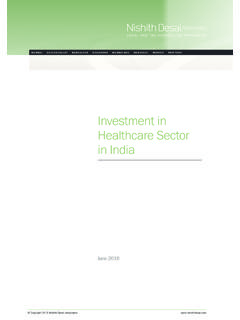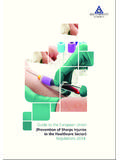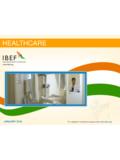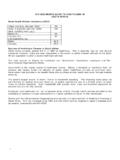Transcription of Spotlight on statistics - WHO
1 Gender and health workforce statisticsSpotlight on statistics is a series of fact fi les on health workforce statistics produced by the Department of Human Resources for Health, World Health Organization. For more information, please contact: Visit our web site: make up about 42% of the estimated global paid working population. Within the health sector, in many countries women comprise over 75% of the workforce, making them indispensable as contributors to the delivery of health care services. However, in many countries, women still tend to be concentrated in the lower-status health occupations, and to be a minority among more highly trained professionals. In particular, the distribution of women by occupational category tends to be skewed in favour of nursing and midwifery personnel and other caring cadres such as community health workers. Women are often poorly represented in other categories, physicians, dentists, pharmacists and managers.
2 The under-representation of women in managerial and decision making positions may lead to less attention to and poorer understanding of both the particular features of working conditions that characterize much of women s employment, and the health care needs specifi c to women. In many contexts, access to female providers is an important determinant of women s health service utilization patterns. Omission of gender considerations may also lead to inadequate health system responsiveness to the needs of men: for example, reproductive health services are often not set up so as to encourage male involvement. Gender analysis of the health workforce may reveal that health systems themselves can refl ect or even exacerbate many of the social inequalities they are meant to address and be immune from. Participatory approaches in health workforce planning, development and management should be ensured, where both women and men health workers are given an active role to ensure that research being undertaken is relevant to their needs and interests.
3 Research, policy and programme eff orts to address gender equality in the health workforce should lead to strengthened health systems more analysis of the health workforce The collection, processing, dissemination and use of sex-disaggregated data can help to plan, monitor and evaluate successful gender-sensitive interventions in the work place, bringing attention to the ways in which social and behavioural diff erences between women and men may lead to inequities in working conditions in the health sector and, ultimately, in inequities between women s and men s access to health care services and health outcomes. Access to reliable, timely information on gender and the health workforce can inform the steps needed to achieve gender equity. A strategy for gender analysis of the health workforce should include four key components: Building capacity at the international, national and sub-national levels for gender analysis in workforce policy and planning; Refl ection of gender in national health workforce de-velopment budgets; Promoting the use of sex-disaggregated data in mon-itoring and evaluation activities at all levels; and Establishing tools, methods and approaches for health workforce analysis, originally developed in relation to predominantly male employment sectors, should be validated and extended for analyses of women s jobs.
4 Analyses of working conditions should consider factors more specifi cally aff ecting women workers, such as physical work loads, reconciling work and family, relations with clients and sexual harassment. For example, some incentives for addressing worker productivity and retention may be more favourable to female than to male workers, such as fl exible leave arrangements and career-break schemes. Monitoring, assessing and reporting country experiences of these indicators should be the same time, caution should be taken to avoid over-emphasizing gender diff erences, in relation to other characteristics relevant to health workforce studies. Education and training, access to resources, client volume, supervision and age are among the many other explanatory variables involved in processes that characterize health worker productivity and fact file on health workforce statisticsSpotlighton statisticsIssue 2, February 2008 Sex distribution of the health workforce, selected countries, labour force survey data0255075100 AustriaCanadaDenmarkGermanyHungaryNether landsRussian FederationSpainSwitzerlandUnited KingdomUnited States of America% femaleSource: Gupta et al.
5 , 2003 Next issue: Monitoring education and training for health workers Selected statisticsThree main employment dimensions have been identifi ed as the starting point for the study of gender equality in the labour force: occupation, working time and earnings. Occupational segregation by gender can correspond to either vertical clustering (diff erentials in the sex ratio according to relative job status) or horizontal clustering (sex diff erentials according to specialization). Working time can aff ect workers economic position, especially when it results in lower monetary and non-monetary compensation among part-time workers compared to their full-time counterparts, as well as less job security and fewer opportunities for promotion. Because the labour conditions and opportunities vary markedly across occupations and countries, gender equity can be referred to as the absence of observed gender diff erences.
6 Presented here are some statistics relevant to gender analysis of the health workforce for selected countries with developed market economies and economies in transition, as compiled drawing on data from national labour force and employment surveys archived by the Luxemburg Income Study [ ]. Labour force surveys off er an advantage for conducting analyses on gender and work because they provide nationally representative data on a number of labour market variables that can be disaggregated by general among the selected countries, health occupations were found to be subject to both vertical and horizontal gender imbalances. The proportion of women was considerably higher for occupations at the associate professional level compared to the professional level, and also for nursing and midwifery professionals compared to physicians and other health professionals. In some countries, women represented over 90% of nursing and midwifery gender diff erences were observed in some countries in working time, measured as the usual number of hours worked per week, including overtime and second jobs.
7 Women tended to average fewer hours than men. Marked diff erences were found in average wages by gender. Women of all cadres tended to earn signifi cantly less than their male counterparts. Exceptions were found for certain occupations in the Russian Federation. Given the longer history of high female labour force participation in transitional countries, along with social policies emphasizing equality and supporting working women and their families, gender imbalances may be expected to be less pronounced compared to countries with developed market and suggested readings Sen G, Ostlin P, George A, Gender Inequity in Health: Why it exits and how we can change it. Report prepared for the WHO Commission on the Social Determinants of Health, September 2007. [ ] George A, Human Resources for Health: A Gender Analysis. Review paper prepared for the WHO Commission on the Social Determinants of Health, July 2007.
8 [ ] World Health Organization, Gender Equality, Work and Health: A Review of the Evidence. Geneva: World Health Organization, 2006. [ ] Gupta N, Diallo K, Zurn P, Dal Poz MR, Assessing human resources for health: what can be learned from labour force surveys? Human Resources for Health 2003, 1:5. [ ] Standing H, Gender - A Missing Dimension in Human Resource Policy and Planning for Health Reforms. Human Resources Development Journal 2000, 4:1 [ ].Please contact us with your questions and comments: Visit our web site: : Gupta et al., 2003 Sex distribution of the health workforce, by cadre0255075100 DenmarkNetherlandsRussian FederationUnited KingdomUnited States ofAmerica% femaleOther health associate professionalsNursing & midwifery associate professionalsOther health professionalsNursing & midwifery professionalsPhysiciansGender gap in hours worked, by FederationUnited KingdomUnited States ofAmericaRatio of women's to men's average hours worked Other health associateprofessionalsNursing & midwiferyassociate professionalsOther healthprofessionalsPhysiciansGender gap in occupational earnings, by KingdomUnited States ofAmericaRatio of women's to men's average earnings Other health associateprofessionalsNursing & midwiferyassociate professionalsNursing & midwiferyprofessionalsPhysicians


















